
A cart or dray is a vehicle designed for transport, using two wheels and normally pulled by draught animals such as horses, donkeys, mules and oxen, or even smaller animals such as goats or large dogs.

A carriage is a private four-wheeled vehicle for people and is most commonly horse-drawn. Second-hand private carriages were common public transport, the equivalent of modern cars used as taxis. Carriage suspensions are by leather strapping or, on those made in recent centuries, steel springs. Two-wheeled carriages are informal and usually owner-driven.

A wheelbarrow is a small hand-propelled load-bearing vehicle, usually with just one wheel, designed to be pushed and guided by a single person using two handles at the rear. The term "wheelbarrow" is made of two words: "wheel" and "barrow." "Barrow" is a derivation of the Old English "barew" which was a device used for carrying loads.

The First Battle of Panipat, on 21 April 1526 was fought between the invading forces of Babur and the Lodi dynasty. It took place in North India and marked the beginning of the Mughal Empire and the end of the Delhi Sultanate. This was one of the earliest battles involving gunpowder firearms and field artillery in the Indian subcontinent which were introduced by Mughals in this battle.

A wagon or waggon is a heavy four-wheeled vehicle pulled by draught animals or on occasion by humans, used for transporting goods, commodities, agricultural materials, supplies and sometimes people.

In the common law of crime in England and Wales, a common scold was a type of public nuisance—a troublesome and angry person who broke the public peace by habitually chastising, arguing, and quarrelling with their neighbours. Most punished for scolding were women, though men could be found to be scolds.

Ducking stools or cucking stools were chairs formerly used for punishment of disorderly women, scolds, and dishonest tradesmen in medieval Europe and elsewhere at later times. The cucking-stool was a form of wymen pine, or "women's punishment", as referred to in Langland's Piers Plowman (1378). They were instruments of public humiliation and censure both primarily for the offense of scolding or backbiting and less often for sexual offences like bearing an illegitimate child or prostitution.

A limber is a two-wheeled cart designed to support the trail of an artillery piece, or the stock of a field carriage such as a caisson or traveling forge, allowing it to be towed. The trail is the hinder end of the stock of a gun-carriage, which rests or slides on the ground when the carriage is unlimbered.

An oxOKS, also known as a bullock, is a bovine, trained and used as a draft animal. Oxen are commonly castrated adult male cattle; castration inhibits testosterone and aggression, which makes the males docile and safer to work with. Cows or bulls may also be used in some areas.

The Sicilian cart is an ornate, colorful style of horse or donkey-drawn cart native to the island of Sicily, in Italy.
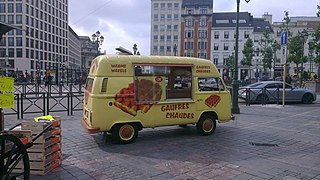
Mobile catering is the business of selling prepared food from some sort of vehicle. It is a feature of urban culture in many countries. Mobile catering can be performed using food trucks, trailers, carts and food stands with many types of foods that can be prepared. Mobile catering is also used to provide food to people during times of emergency.
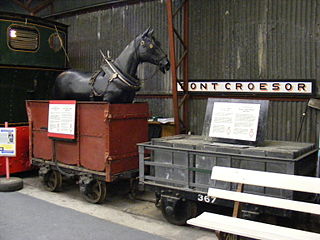
The dandy waggon is a type of railway carriage used to carry horses on gravity trains. They are particularly associated with the narrow gauge Festiniog Railway (FR) in Wales where they were used between 1836 and 1863.
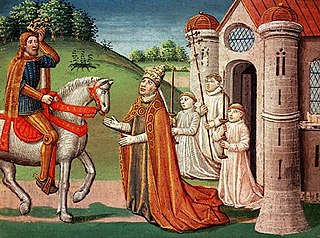
Horses in the Middle Ages differed in size, build and breed from the modern horse, and were, on average, smaller. They were also more central to society than their modern counterparts, being essential for war, agriculture, and transport.

A Lyle gun was a line thrower powered by a short-barrelled cannon. It was invented by Captain David A. Lyle, US Army, a graduate of West Point and the Massachusetts Institute of Technology, and was used from the late 19th century to 1952, when it was replaced by rockets for throwing lines.

Driving, when applied to horses, ponies, mules, or donkeys, is a broad term for hitching equines to a wagon, carriage, cart, sleigh, or other horse-drawn vehicle by means of a harness and working them in this way. It encompasses a wide range of activities from pleasure driving, to harness racing, to farm work, horse shows, and even international combined driving.
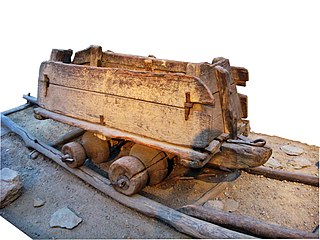
A minecart, mine cart, or mine car is a type of rolling stock found on a mine railway, used for moving ore and materials procured in the process of traditional mining. Minecarts are seldom used in modern operations, having largely been superseded in underground operations by more efficient belt conveyor systems that allow machines such as longwall shearers and continuous miners to operate at their full capacity, and above ground by large dumpers.
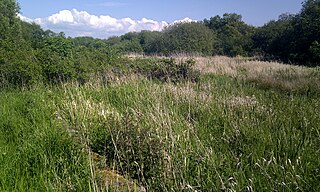
The Stevenston Canal was a waterway in North Ayrshire, Scotland, built for Robert Reid Cunningham of Seabank and Patrick Warner of the Ardeer Estate, which ran to the port of Saltcoats from Ardeer, and Stevenston with a number of short branches to coal pits along the length of the cut. The canal opened on 19 September 1772, the first commercial canal in Scotland. It closed in the 1830s, when it was abandoned following the exhaustion of the coal mines and the rise of importance of Ardrossan as a harbour. At the time of its construction it was said to be the "most complete water system of colliery transport ever devised in Britain."

In medieval France a chasse-marée was a cart designed to carry fresh fish to inland markets, with a minimum of weight put into construction and provision for harnessing four horses.

Happisburgh Lifeboat Station is a Royal National Lifeboat Institution (RNLI) Inshore lifeboat station close to the village of Happisburgh in the English county of Norfolk in the United Kingdom. Since 2003 the station boathouse has been re-located from the village to an area south called Cart Gap. This is because the beach below Happisburgh disappeared due to coastal erosion and the stations slipway and access was washed away. The original boathouse in the village is now used for training. There are currently two inshore lifeboats station at Happisburgh, an Atlantic 85-class inshore lifeboat called Howard Bell (B-899), and a D-class (IB1) inshore lifeboat called Russell Pickering (D-813)
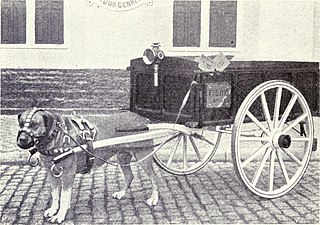
A drafting dog, pulling dog, or draft dog is a dog bred and traditionally used for pulling a dogcart, or in winter also for sled pulling. Dogs bred for this work have strong builds. Many draft dogs are either mastiffs or of livestock guardian descent, both of which are dogs that are solidly-built.




















